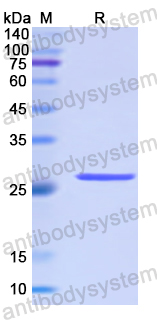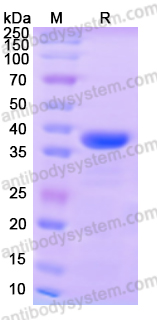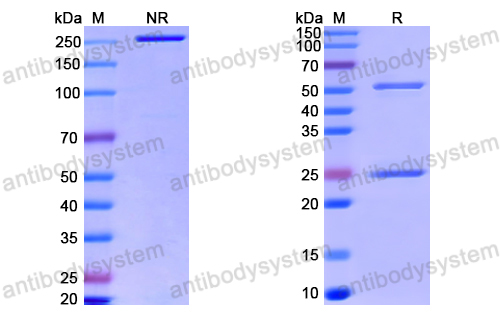Catalog No.
YHG03401
Expression system
E. coli
Species
Homo sapiens (Human)
Protein length
His1092-Leu1316
Predicted molecular weight
28.35 kDa
Nature
Recombinant
Endotoxin level
Please contact with the lab for this information.
Purity
>90% as determined by SDS-PAGE.
Accession
Q04912
Applications
ELISA, Immunogen, SDS-PAGE, WB, Bioactivity testing in progress
Form
Lyophilized
Storage buffer
Lyophilized from a solution in PBS pH 7.4, 0.02% NLS, 1mM EDTA, 4% Trehalose, 1% Mannitol.
Reconstitution
Reconstitute in sterile water for a stock solution. A copy of datasheet will be provided with the products, please refer to it for details.
Shipping
In general, proteins are provided as lyophilized powder/frozen liquid. They are shipped out with dry ice/blue ice unless customers require otherwise.
Stability and Storage
Use a manual defrost freezer and avoid repeated freeze thaw cycles. Store at 2 to 8°C for frequent use. Store at -20 to -80°C for twelve months from the date of receipt.
Alternative Names
CD136, Macrophage-stimulating protein receptor, PTK8, MST1R, p185-Ron, RON, CDw136, MSP receptor, Protein-tyrosine kinase 8
RON Receptor Signaling and the Tumor Microenvironment., PMID:40282397
Humanized dual-targeting antibody-drug conjugates specific to MET and RON receptors as a pharmaceutical strategy for the treatment of cancers exhibiting phenotypic heterogeneity., PMID:39837982
Nuclear translocation of RON receptor tyrosine kinase. New mechanistic and functional insights., PMID:39794156
RON receptor tyrosine kinase as a critical determinant in promoting tumorigenic behaviors of bladder cancer cells through regulating MMP12 and HIF-2α pathways., PMID:39557851
RON receptor tyrosine kinase regulates glycolysis through MAPK/CREB signaling to affect ferroptosis and chemotherapy sensitivity of thyroid cancer cells., PMID:39422033
Conformational variability in the D2 loop of Plasmodium Apical Membrane antigen 1., PMID:39324028
The MET Family of Receptor Tyrosine Kinases Promotes a Shift to Pro-Tumor Metabolism., PMID:39062731
The immunohistochemical expression of c-MET and RON in lung adenocarcinoma with clinicopathologic correlation., PMID:38847203
Oroxylin A suppresses breast cancer-induced osteoclastogenesis and osteolysis as a natural RON inhibitor., PMID:38728920
The Clinical Significance of CD163+ Tumor-Associated Macrophages (TAMs) in Laryngeal Squamous Cell Carcinoma., PMID:37082492
MST1R as a potential new target antigen of chimeric antigen receptor T cells to treat solid tumors., PMID:37078298
RON-augmented cholesterol biosynthesis in breast cancer metastatic progression and recurrence., PMID:37029299
An Introduction and Overview of RON Receptor Tyrosine Kinase Signaling., PMID:36833444
An alignment-independent three-dimensional quantitative structure-activity relationship study on ron receptor tyrosine kinase inhibitors., PMID:35880255
Prostate tumor RON receptor signaling mediates macrophage recruitment to drive androgen deprivation therapy resistance through Gas6-mediated Axl and RON signaling., PMID:35860905
Reply to Qiu et al.: Hunting for leadership "causal" genes: Mission possible?, PMID:35787186
Genetic variant rs9848497 up-regulates MST1R expression, thereby influencing leadership phenotypes., PMID:35787185
Plasma membrane proteoglycans syndecan-2 and syndecan-4 engage with EGFR and RON kinase to sustain carcinoma cell cycle progression., PMID:35569509
The expanding family of c-Met inhibitors in solid tumors: a comparative analysis of their pharmacologic and clinical differences., PMID:35063635
EGFR transactivates RON to drive oncogenic crosstalk., PMID:34821550
Macrophage-mediated RON signaling supports breast cancer growth and progression through modulation of IL-35., PMID:34743208
RON Mediates Tumor-Promoting Effects in Endometrial Adenocarcinoma., PMID:34712728
A potential signaling axis between RON kinase receptor and hypoxia-inducible factor-1 alpha in pancreatic cancer., PMID:34347914
Autocrine signaling by receptor tyrosine kinases in urothelial carcinoma of the bladder., PMID:34292953
Structural insights into an atypical secretory pathway kinase crucial for Toxoplasma gondii invasion., PMID:34145271
High glucose induced c-Met activation promotes aggressive phenotype and regulates expression of glucose metabolism genes in HCC cells., PMID:34059694
IL-4, IL-17 and CD163 Immunoexpression and IL-6 Gene Polymorphism in Chronic Hepatitis C Patients and Associated Hepatocellular Carcinoma., PMID:33906302
Hepatocyte growth factor induces pErk and pSTAT3 (Ser 727) to promote mitochondrial activity and neurite outgrowth in primary dorsal root ganglion cultures., PMID:33788814
The MSP-RON pathway regulates liver fibrosis through transforming growth factor beta-dependent epithelial-mesenchymal transition., PMID:33786995
Evidence for 2-Methoxyestradiol-Mediated Inhibition of Receptor Tyrosine Kinase RON in the Management of Prostate Cancer., PMID:33673346
Tumor cell intrinsic RON signaling suppresses innate immune responses in breast cancer through inhibition of IRAK4 signaling., PMID:33508385
Multi-Component Reactions of Cyclohexan-1,3-dione: Synthesis of Fused Pyran, Pyridine, Thiophene and Pyrazole Derivatives with c-Met, Anti-Proliferative Activities., PMID:33438568
Dnmt3b catalytic activity is critical for its tumour suppressor function in lymphomagenesis and is associated with c-Met oncogenic signalling., PMID:33418509
Recepteur d'origine nantais contributes to the development of endometriosis via promoting epithelial-mesenchymal transition of a endometrial epithelial cells., PMID:33410267
Ligand-based Discovery of Novel Small Molecule Inhibitors of RON Receptor Tyrosine Kinase., PMID:33274845
RON signalling promotes therapeutic resistance in ESR1 mutant breast cancer., PMID:33257837
MSP-RON Pathway: Potential Regulator of Inflammation and Innate Immunity., PMID:33117355
circCRAMP1L is a novel biomarker of preeclampsia risk and may play a role in preeclampsia pathogenesis via regulation of the MSP/RON axis in trophoblasts., PMID:33109096
Prognostic role of the recepteur d'origine nantais (RON) expression in primary high-grade osteosarcoma., PMID:32972820
MET and RON receptor tyrosine kinases in colorectal adenocarcinoma: molecular features as drug targets and antibody-drug conjugates for therapy., PMID:32962738
The long noncoding RNA FTX promotes a malignant phenotype in bone marrow mesenchymal stem cells via the miR-186/c-Met axis., PMID:32853911
Candida tropicalis RON1 is required for hyphal formation, biofilm development, and virulence but is dispensable for N-acetylglucosamine catabolism., PMID:32712662
[A method for reliable detection of genomic point mutations based on single-cell target-sequencing]., PMID:32694109
The HNRNPA2B1-MST1R-Akt axis contributes to epithelial-to-mesenchymal transition in head and neck cancer., PMID:32669614
LncRNA SNHG4 promotes the increased growth of endometrial tissue outside the uterine cavity via regulating c-Met mediated by miR-148a-3p., PMID:32525017
The MSP-RON axis stimulates cancer cell growth in models of triple negative breast cancer., PMID:32484599
Antibody-drug conjugates targeting RON receptor tyrosine kinase as a novel strategy for treatment of triple-negative breast cancer., PMID:32479905
Brn3a/Pou4f1 Functions as a Tumor Suppressor by Targeting c-MET/STAT3 Signaling in Thyroid Cancer., PMID:32474599
Prostate Epithelial RON Signaling Promotes M2 Macrophage Activation to Drive Prostate Tumor Growth and Progression., PMID:32439702
Short-form RON (sf-RON) enhances glucose metabolism to promote cell proliferation via activating β-catenin/SIX1 signaling pathway in gastric cancer., PMID:32399910



